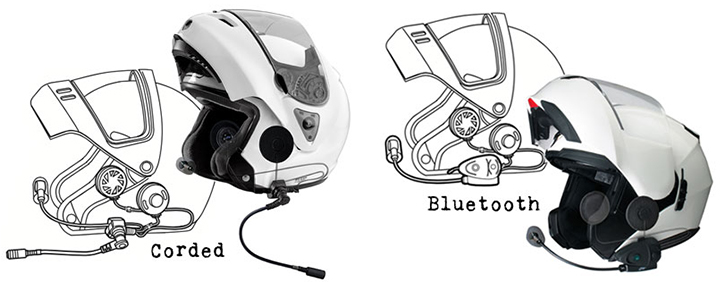
Back in the day, riders "communicated" by using awkward looking hand signals, smacking the back of the rider's helmet, and screaming at each other, competing against highway speed winds for one another's attention. Remember that? Good riddance.
Nowadays we have high-tech headsets designed to make communication while riding easier and safer than ever. No more shouting. No more rider abuse. Instead it's chatting with your co-rider, effortlessly talking with other riders and listening to your favorite music all at a push of a button. My how the times have changed.
So you're in the market for a new headset and you're not 100% sure which type you should get: Corded or Bluetooth. Don't worry, we've got you covered!
Before you slide out your credit card and make the purchase, keep in mind that riders have different preferences, different expectations and a variation of perceived needs when it comes to many aspects of their motorcycle. It's no different when it comes to buying a headset. There's a lot that can be said about Corded and Bluetooth Headsets and a myriad of reasons why a rider would swear by one over the other. In this article, we will look at the pros and cons of each in order to help you choose the option that best suits your needs.*
Side Note: Are you looking for a helmet/headset combo and not sure where to start? Check out our blog post: How To Determine the Helmet/Headset Combo That's Right for You

This type of headset has been around since that beginning and, for some, that is reason enough to stick with the corded option. Many riders feel comfortable and know what to expect with this setup. They're reluctant to try out an expensive Bluetooth unit, only to be thwarted by it's unfamiliarity. In a way, it's like choosing between that restaurant you ALWAYS go to or shaking things up and trying Thai food for the first time at the place that just opened up. Think of it as the "Go-With-What-You-Know" mentality.
Let's take a look at the pros and cons of owning a Corded Headset below:
Pros
Cons

These units arrived on the scene more recently and many riders prefer them because of their easy-to-use integration with cell phone and GPS units and helmet-to-helmet communications while riding most any motorcycle, without needing a built-in audio system. Of course, the biggest advantage: No annoying cords to get in the way. That said, there are more than a few drawbacks to owning a Bluetooth setup that you should be aware of.
Let's look at the pros and cons of owning a Bluetooth Headset below:
Pros
Cons
So there you have it. There are really good aspects to both and some drawbacks as well. In our experience, the choice really comes down to rider preference more than anything else. If you've never owned a Bluetooth headset, maybe it's time that you branch out and try something new. Who knows, maybe you'll love it. On the other hand, you might be completely satisfied with the corded headset you already own and have no reason change it up. That's perfectly fine as well. What's most important is that you are happy with your setup. If not, give us a call and we'll be glad to help you out!
* Much of this great information was provided by J&M Corp.
austin
09.28.2015